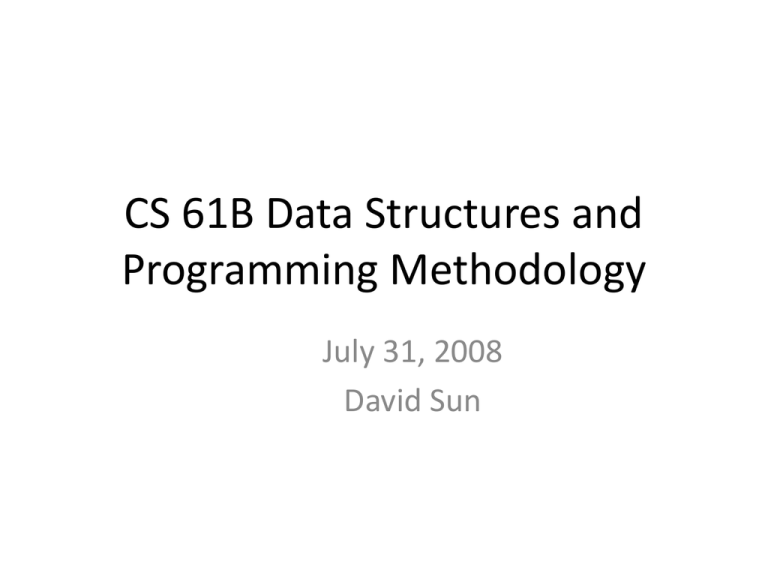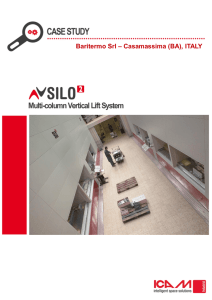Project 3
advertisement

CS 61B Data Structures and
Programming Methodology
July 31, 2008
David Sun
Announcements
• Midterm II results available on glookup.
– Mean 37.3 / 50
– Std Dev: 9
• Midterm II papers will be returned to you during
discussion sections.
• Same re-grading policies as last time.
– Write a note and tell us what you think was incorrectly
graded. Hand it to me or one of the t.a.s. Check you
solution against the solution online to make sure you
won’t loose more points than you’d gain.
– Best to get it to us before the end of next week.
Project 3
• Sliding block puzzle:
– A tray stores of a number of rectangular blocks, the
game is to slide the pieces without lifting any out of
the tray, until achieving a certain configuration.
• Write a program that solves a sliding block
puzzle in as little execution time as possible.
– Need not find the shortest possible sequence of
move.
Initial Configuration
• Input: a file containing an encoding of the
initial tray configuration.
5
2
2
2
2
2
1
1
1
1
1
4
1
1
1
1
2
2
1
1
1
1
0
0
2
2
1
3
4
4
4
4
0
3
0
3
1
1
0
1
2
3
(0, 0) 1
2
5
4
Goal Configuration
• Input: a file that specifies an encoding of the
final or goal configuration.
– This file does not contain entries for all blocks in
the tray.
– Blocks may appear in any order in this file.
1131
1142
1132
2 2 3 1
Solution
• A sequence of moves of blocks that turns the initial
configuration to the in the goal.
• Legal moves:
– Slide block horizontally or vertically into adjacent empty
space.
– Blocks may only be moved an integer number of spaces.
– Either the row or the column will be the same in the start
position as in the end position for each move.
Format of Solution
• Sequence of block movements that lead to a solution.
• Each such line will contain four integers: the starting row and
column of the upper left corner of the moving block, followed
by the upper left corner's updated coordinates.
1101
3121
4131
4232
4042
move the 2x2 block up
move the 1x2 block up
move a 1x1 block up
move another 1x1 block up
move the leftmost 1x1 block two spaces over
The Game
• Your program will search the tree of possible
move sequences to find a solution to the puzzle.
• Top level algorithm:
0. Initialization – read in the init and goal
configurations.
1. Generate moves from the current configuration
2. Pick a move
3. Update the current configuration
4. Continue if the current configuration does not match
the end configuration
Key Design Designs
• Should I traverse the possible configurations breadth first or
depth first?
– Either way, you’ll likely hit some resource limit.
• DFS:
– If you find a solution you don't know whether it is the best solution
or not.
– You can run into a very deep branch in the search tree before hitting
the solution or the stack may over flow
– Can try bounding the search at some fixed depth, and do iterative
deepening if solution doesn’t exist.
• BFS
– First solution is the most optimal solution, i.e. minimal number of
steps
– If there are many empty spaces in a configuration, the set of
possible moves from any given configuration can be huge. Your
search tree will be very wide, and the queue will run out of memory
before you hit a solution.
Preventing Cycles
• How do I prevent cycles?
– Some way of remembering the search path I’ve
taken or the configurations I’ve seen.
– Maybe use a hash tables – O(1) lookup time if
designed well.
– Not just look up time though, how long does it
take to compute the hash code?
Key Data Structure
• Tray: representation of the current configuration of the
board.
–
–
–
–
How do I represent the blocks?
How do I represent the empty spaces?
Should I represent the empty spaces explicitly?
Should I represent the blocks explicitly?
• Tray representation will affect:
– How you read in the configuration files
– How you find the moves to generate from the current
configuration
– How you update a configurations.
– How you hash the configurations.
– How you compare configurations.
– How long you can grow the stack or queue before the it
explodes.
One Design
class Tray {
//unsorted, added in the order specified in the
//init config file
ArrayList<Blocks> config;
. . .
class Blocks {
int row;
int col;
int length;
int width;
. . .
}
What are some of the issues with this
design?
Implementation Advice
• Think carefully about how the tray should be
represented but do not dwell on it for too long.
• Get the brute-force (exhaustive search) working
on the easy puzzles before start tuning.
• Don’t waste your time on finding an optimal
solution. Test your algorithm on the input and
output files and see if it works reasonably well!
• Time the modules in your code to find where the
bottle necks are!
– May yield surprises…
– There are many timing facilities in Java that let’s you
do this.
Main Modules?
Testing
• Checker program that checks whether a given sequence
of moves solves a given puzzle.
– Takes an initial configuration and a goal configuration in the
same format as those for Solver.java.
– Takes a sequence of moves, in the format to be produced by
Solver.java, as standard input.
– Its output indicates whether the moves solve the puzzle, and
if not, why not.
• 3 sets of testing files:
– Easy: 50 points if you solve almost all of them.
– Medium: get no points for solving these.
– Hard: 2 points for each hard puzzle you solve under 2
minutes.
Debug Info
• An optional first argument will be a string whose
first two characters are "–o" and whose
remaining characters specify information about
what debugging output the program should
produce.
• You may choose the format of this information.
• You may choose any debugging information to
output
– Doesn’t need to a whole lot
– Demonstrates to us that you used some form of
debugging output to help you verifying the result.
Useful Debugging Info?
HW for next Monday
• Earn up to 8 points,
8
Completion of 3 of the tasks listed below, with evidence that they work correctly.
7
Completion of 2 of the tasks listed below, with evidence that it works correctly, plus
significant progress on one of the other tasks.
6
Completion of 2 of the tasks listed below
5
Completion of 1 of the tasks listed below, with evidence that it works correctly, plus
significant progress on one of the other tasks.
4
Completion of 1 of the tasks listed below
2
No working code, but with one of the tasks below almost implemented.
0
No apparent progress on the project.
• The tasks:
–
–
–
–
–
input of blocks from a file into a tray data structure
comparison of a tray with a goal configuration
generating moves from a given configuration
making a move
implementation of a good hashing scheme

